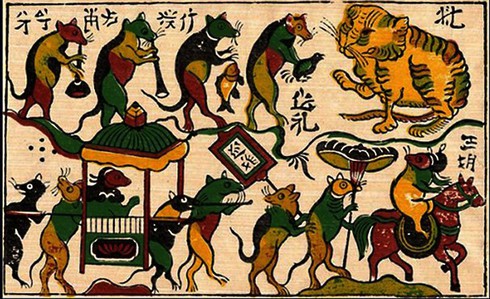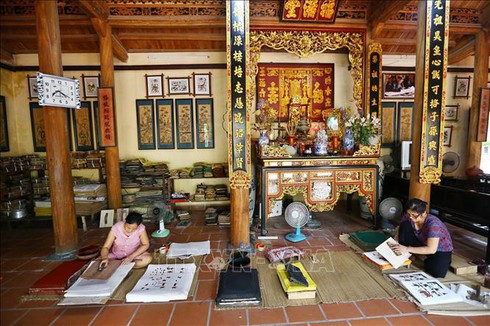 |
|
"Mice's wedding" is one of the best known Dong Ho paintings.
|
To this end, local artisans and administrators have spared no effort to make the paintings popular again.
Dong Ho folk paintings are printed from woodblocks and created by Dong Ho villagers in Bac Ninh province. As this genre of paintings mirrors Vietnam’s traditional agricultural society and customs, everyday life images like pigs, chicken, and coconut picking are common in Dong Ho works.
Each painting sends a philosophic message about morality, ethics, and religious beliefs, according to veteran artisan Nguyen Dang Che.
Some Dong Ho paintings are well-known for their interesting themes like “Dam cuoi chuot” (Mice’s wedding) which features a wedding march of mice with the bride, the groom and guests delivering gifts to a big cat in the hope that the cat will leave the happy couple alone.
“Mice’s wedding” is the most popular. It’s a kind of satirical painting,” said Che.
Dong Ho paintings are unique in their color and printing paper. The paper made from the bark of Do (poonah) tree is thin, soft, spongy, and absorbent.
“The colors are refined from natural materials which are common in Vietnam. For instance, the white color is taken from seashells, red is from red gravel,and black comes from charcoal of burned bamboo leaves,” Che elaborated.
 |
|
Nguyen Dang Che's Dong Ho painting preservation center (Photo: VNA)
|
Dong Ho painting enjoyed its heyday from the late 19th century until the 1940s when all 17 clans in the village were involved in the craft. Now the number has dwindled to two.
Nguyen Dang Che’s family has invested US$130,000 to build a preservation center which includes a workshop to serve visitors and educate younger villagers.
“This is a place where Dong Ho painting is well preserved. We are lucky to have it,” said historian Le Van Lan.
The offspring of artisan Nguyen Huu Sam are working hard to revive Dong Ho painting. His daughter-in-law, Nguyen Thi Oanh, is the village’s first female artisan.
“Dong Ho painting is fading. We are trying to create new motifs to diversify our products,” said Mrs. Oanh.
“We must pay due attention to the community where Dong Ho painting originated from. We have organized workshops to promote the paintings to the wider public and sought ways to expand outlets for the products,” said Nguyen Van Phong, Vice Chairman of the Bac Ninh provincial People’s Committee.
Ta Quang Dong, Deputy Minister of Culture, Sports, and Tourism said, “We are working to pass the craft to the younger generation. UNESCO’s recognition will create new momentum for Dong Ho folk paintings to regain their popularity.” VOV
 Bac Ninh province has completed a dossier seeking UNESCO’s inclusion of the making of Dong Ho folk paintings on the list of intangible cultural heritage in need of urgent protection.
Bac Ninh province has completed a dossier seeking UNESCO’s inclusion of the making of Dong Ho folk paintings on the list of intangible cultural heritage in need of urgent protection.